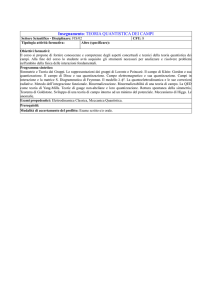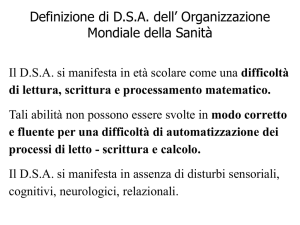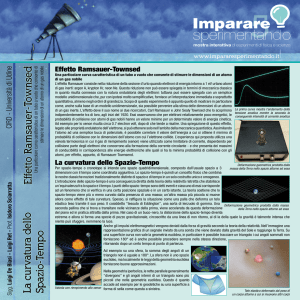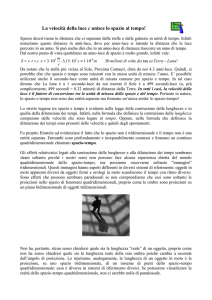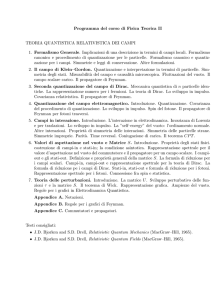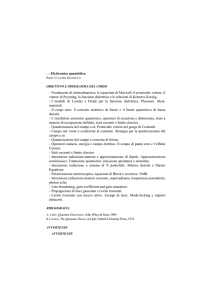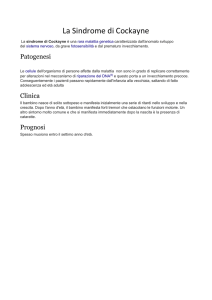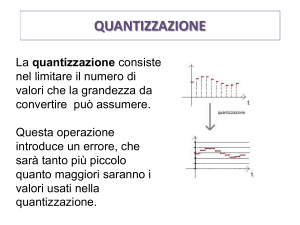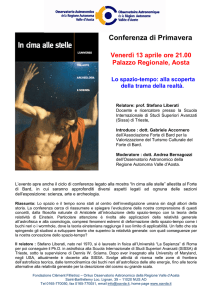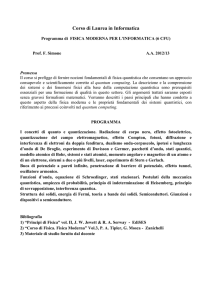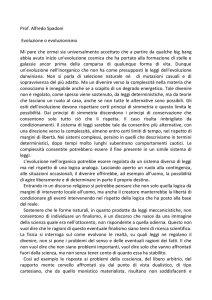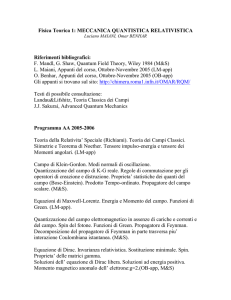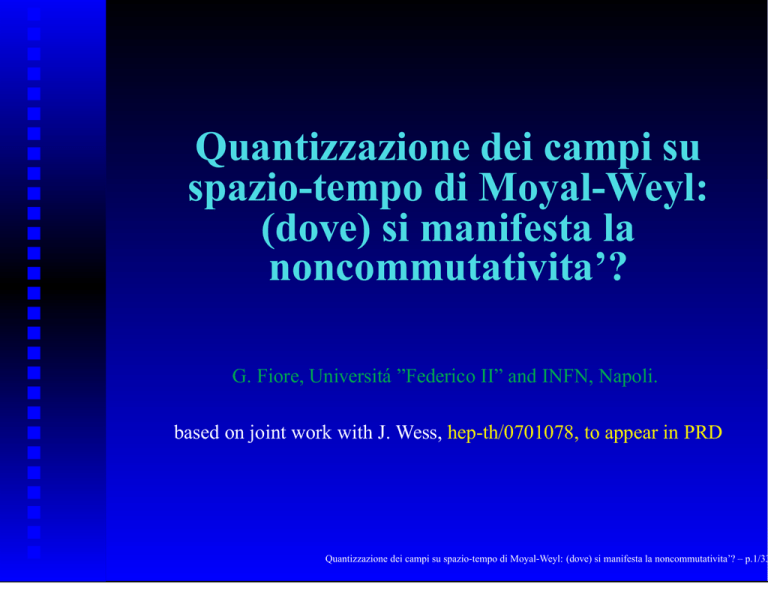
Quantizzazione dei campi su
spazio-tempo di Moyal-Weyl:
(dove) si manifesta la
noncommutativita’?
G. Fiore, Universitá ”Federico II” and INFN, Napoli.
based on joint work with J. Wess, hep-th/0701078, to appear in PRD
Quantizzazione dei campi su spazio-tempo di Moyal-Weyl: (dove) si manifesta la noncommutativita’? – p.1/33
Introduction
The idea of spacetime NC is rather old: goes back to Heisenberg.
Simplest NC: constant commutators
Moyal-Weyl space:
[x̂µ , x̂ν ] = i1θµν
(1)
Algebra Ab of functions on Moyal-Weyl space: generated by
1, x̂µ fulfilling (1). With µ = 0, 1, 2, 3 and ηµν : deformed
Minkowski space. θµν = 0: A generated by commuting xµ .
(1) are translation invariant, not Lorentz-covariant.
Contributions to the construction of QFT on it start in 1994-95.
I would divide them into 3 groups, according to the used
approaches. By no means are they equivalent!
Quantizzazione dei campi su spazio-tempo di Moyal-Weyl: (dove) si manifesta la noncommutativita’? – p.2/33
1. DFR Approach
(Doplicher, Fredenhagen, Roberts 1994-95; Bahns, Piacitelli,..a):
field quantization in (rigorous) operator formalism on def.
Minkowski space. (1) motivated by the interplay of QM and GR
in what they call the Principle of gravitational stability against
localization of events:
The gravitational field generated by the concentration of energy
required by the Heisenberg Uncertainty Principle to localise an
event in spacetime should not be so strong to hide the event itself
to any distant observer - distant compared to the Planck scale.
(Goes back to Wheeler?)
Quantizzazione dei campi su spazio-tempo di Moyal-Weyl: (dove) si manifesta la noncommutativita’? – p.3/33
In the first, simplest version θµν are not fixed constants, but
central operators (obeying additional conditions) which on each
irrep become fixed constants σ µν , the joint spectrum of θµν .
In more recent versions θµν is no more central, but commutation
relations remain of Lie-algebra type.
But the wished Lorentz covariance is sooner or later lost.
Speculations by Doplicher: θµν should be finally related to v.e.v.
of Rµν , which in turn should be influenced by the presence of
matter quantum fields in spacetime (through quantum equations
of motions).
Quantizzazione dei campi su spazio-tempo di Moyal-Weyl: (dove) si manifesta la noncommutativita’? – p.4/33
2. (Naive) path-integral quantization on R4θ
(Filk 1996,...). Main initial motivation: effective theory from
string theory in a constant background B-field (A lot of string
theorists: N. Seiberg, E. Witten, M. R. Douglas, A.S. Schwarz,
S. Minwalla, M. Van Raamsdonk, N. Seiberg, J. Gomis, T.
Mehen, L. Alvarez-Gaume, M.A. Vazquez-Mozo, M. R.
Douglas, N. A. Nekrasov, R.J. Szabo,....).
(Wick-rotated) Lorentz covariance is lost, but this is expected in
effective string theory because of the B-field.
Many pathologies: violation of causality, non-unitarity (for
θ0i 6= 0), UV-IR mixing of divergences, subsequent
non-renormalizability, claimed changes of statistics, etc.
Quantizzazione dei campi su spazio-tempo di Moyal-Weyl: (dove) si manifesta la noncommutativita’? – p.5/33
UV-IR MIXING:
Planar Feynman diagrams remain as the undeformed, apart from
a phase factor, in particular have the same UV divergences.
Nonplanar Feynman diagrams which were UV divergent become
finite for generic non-zero external momentum, but diverge as
the latter go to zero, even with massive fields: IR divergences!
Quantizzazione dei campi su spazio-tempo di Moyal-Weyl: (dove) si manifesta la noncommutativita’? – p.6/33
3. Twisted Poincaré covariant approaches
This is the framework of our work, subject of this talk.
It recovers Poincaré covariance in a deformed version.
Field quantization either in an operator or in a path-integral
approach (on the Euclidean).
Chaichian et al, Wess, Koch et al, Oeckl:
(1) are twisted Poincaré group covariant.
How to implement twisted Poincaré covariance in QFT?
Different proposals, [Chaichian et al 04,05,06], [Tureanu06],
[Balachandran et al 05,06] [Lizzi et al 06], [Bu et al 06], [Zahn
06], [Abe 06]...:
a) do coordinates x, y of different spacetime points commute?
b) deform the CCR of ap , a†p for free fields?
Quantizzazione dei campi su spazio-tempo di Moyal-Weyl: (dove) si manifesta la noncommutativita’? – p.7/33
Abstract of our contribution
We note that a proper enforcement of the “twisted Poincaré”
covariance of [Chaichian et al], [Wess], [Koch et al], [Oeckl]
requires nontrivial ("braided") commutation relations between
any pair of coordinates x, y generating two different copies of the
Grönewold-Moyal-Weyl space, or equivalently a ⋆-tensor
product f (x) ⋆ g(y) (in the parlance of [Aschieri et al]).
Then all (x − y)µ behave like undeformed coordinates.
Consequently, one can formulate QFT in a way physically
equivalent to the undeformed counterpart, as observables involve
only coordinate differences. (Similarly for n-particle QM)
We briefly comment on what we can learn from these results
Quantizzazione dei campi su spazio-tempo di Moyal-Weyl: (dove) si manifesta la noncommutativita’? – p.8/33
Plan
1. Introduction
2. Twisted Poincaré Hopf algebra, several spacetime
variables, ⋆-products
3. Revisiting Wightman axioms for QFT and their
consequences
4. Free fields
5. Interacting fields
6. (Some) Conclusions?
Quantizzazione dei campi su spazio-tempo di Moyal-Weyl: (dove) si manifesta la noncommutativita’? – p.9/33
2.
The Hopf algebra H ≡ Uθ P
This is U P (P = Poincaré Lie algebra) “twisted” [Drinfel’d 83]
with F: U P, H have
1. same ∗-algebra and counit ε
ˆ related by
2. coproducts ∆, ∆
X
X
−1
I
I
ˆ
∆(g) ≡
g(1) ⊗g(2) −→ ∆(g)
= F∆(g)F ≡
g(I1̂) ⊗g
I
I
The twist F is not uniquely determined. The simplest choice is
P (1)
(2)
i µν
F ≡ I F I ⊗ F I := exp 2 θ Pµ ⊗ Pν .
ˆ µ ) = ∆(Pµ ) = Pµ ⊗ 1 + 1 ⊗ Pµ = ∆(Pµ ),
∆(P
ˆ ω ) = Mω ⊗ 1 + 1 ⊗ Mω + P [ω, θ] ⊗ P 6= ∆(Mω ).
∆(M
Quantizzazione
dei campi su spazio-tempo
di Moyal-Weyl: (dove) si manifesta la noncommutativita’? – p.10/33
where Mω = ω µν Mµν
. Translations
undeformed!
Let ⊲, ˆ⊲ be the (left) actions of U P, H on A, Ab (g ∈ U P acts on
A as the corresponding differential operators, e.g. Pµ ∼ i∂µ ).
• ⊲, ˆ⊲ act in the same way on 1st degree polynomials in xν , x̂ν
Pµ ⊲xρ = iδµρ = Pµ ˆ⊲x̂ρ,
Mω ⊲xρ = 2i(xω)ρ,
Mω ˆ⊲x̂ρ = 2i(x̂ω)
and more generally on irreps (irreducible representations); ⇒
Same classification of elementary particles as unitary irreps of P!
• ⊲, ˆ⊲ differ on higher degree polynomials in xν , x̂ν , and more
generally on tensor products of representations, after the rules
g ⊲(ab) = I g(1) ⊲ a g(2) ⊲ b
I
P
I
g ˆ⊲(âb̂) = I g(1̂) ˆ⊲â g(2̂) ˆ⊲b̂
⇔
P
g ˆ⊲(a⋆b) =
P
I
g(I1̂) ˆ⊲a
⋆
(resp. reducing to usual or deformed Leibniz rule if g = Pµ , Mµν ).
Summarizing: (1) are H-covariant, or Ab is a H-module algebra.
Quantizzazione dei campi su spazio-tempo di Moyal-Weyl: (dove) si manifesta la noncommutativita’? – p.11/33
Several spacetime variables
Let An be the n-fold tensor product algebra of A,
xµ1 ≡ xµ ⊗1⊗...⊗1, xµ2 ≡ 1⊗xµ ⊗...⊗1,...
An is U P-covariant, i.e. [xµi , xνj ] = 0 are compatible with ⊲.
[x̂µi , x̂νj ] = 0 is not compatible with ⊲ˆ (apply e.g. Mω ˆ⊲) .
The H-covariant NC generalization of An is the unital ∗-algebra
n
b
A generated by real variables x̂µi fulfilling
[x̂µi , x̂νj ] = 1iθµν ,
(2)
dictated by the braiding associated to the quasitriangular
structure R = F 21 F −1 of H.
Quantizzazione dei campi su spazio-tempo di Moyal-Weyl: (dove) si manifesta la noncommutativita’? – p.12/33
⋆-Products
n
b
Equivalent formulation of A : For n ≥ 1 let Anθ be the algebra
coinciding with An as a vector space, but with the new product
a ⋆ b :=
P
(1)
I (F I
⊲
(2)
a)(F I
⊲ b),
(3)
with F ≡ F −1 . This encodes both the ⋆-product within each
copy of A, and the “⋆−tensor product” algebra [Aschieri et al].
n
n
b
Aθ has ⋆-commutation relations isomorphic to (??), ⇒ A , Anθ
are isomorphic H-module ∗-algebras: choosing (??) F as in (??,
xµi ⋆xνj = xµi xνj +iθµν /2
⇒
[xµi ⋆, xνj ] = 1iθµν .
In general, (?? gives f (xi )⋆g(xj ) = exp[ 2i ∂xi θ∂xj ]f (xi )g(xj ),
after which we must set xi = xj if i = j.
In the sequel we express NC only by ⋆-products.
Quantizzazione dei campi su spazio-tempo di Moyal-Weyl: (dove) si manifesta la noncommutativita’? – p.13/33
Alternative generators of Anθ
ξiµ = xµi+1 −xµi ,
µ
X =
Pn
µ
a
x
j=1 j j
(i < n,
Pn
j=1
aj = 1
1. [X µ ⋆, X ν ] = 1iθµν , so X µ generate a Aθ,X , whereas ∀b ∈ Anθ
ξiµ ⋆ b = ξiµ b = b ⋆ ξiµ
⇒
[ξiµ ⋆, b] = 0,
(4)
n
n−1
ξiµ generate a ⋆-central subalgebra An−1
,
and
A
∼
A
θ
ξ
ξ ⊗ Aθ,X .
2. An−1
ξ , Aθ,X are actually H-module subalgebras, with
g ˆ⊲a = g ⊲ a
a ∈ An−1
g∈H
ξ ,
g ˆ⊲(a ⋆ b) = g(1) ⊲ a ⋆ g(2) ˆ⊲b ,
b ∈ Anθ ,
(5)
i.e. on An−1
the H-action is undeformed, including the related
ξ
part of the Leibniz rule. [By (10) ⋆ can be also dropped.] All ξiµ
are translation invariant.
Quantizzazione dei campi su spazio-tempo di Moyal-Weyl: (dove) si manifesta la noncommutativita’? – p.14/33
Remark 1. (x−y)µ ⋆ = (x−y)µ ·, same spectral decomposition
on all R (including 0). On each irrep of Anθ this amounts to
multiplication by either a space-like, or a null, or a time-like
4-vector, in the usual sense.
Summing up, coordinate differences can be treated as classical
variables; any xµi is a combination of ⋆-commutative ξiµ and the
⋆-noncommutative X µ , e.g. if X := x1
xi =
i−1
X
ξj + X.
j=1
X =Global “noncommutative translation”.
n
b
1.,2. can be reformulated in terms of x̂i , A , etc. X̂ is like the
“quantum shift operator” of [Chaichian et al].
Quantizzazione dei campi su spazio-tempo di Moyal-Weyl: (dove) si manifesta la noncommutativita’? – p.15/33
The differential calculus is not deformed with θ 6= 0, also on
n
n
b
Aθ (or the isomorphic A ), since Pµ ⊲ ∂xνi = 0:
h
i
∂xµi ⋆ xνj = δµν δji + xνj ⋆ ∂xµi
∂xµi ⋆, ∂xνj = 0 (6)
In the sequel we shall drop the symbol ⋆ beside a derivative.
Also integration over the space is not deformed with θ 6= 0 :
Z
Z
d4 x a ⋆ b = d4 x ab
(7)
Stoke’s theorem still applies.
Quantizzazione dei campi su spazio-tempo di Moyal-Weyl: (dove) si manifesta la noncommutativita’? – p.16/33
Consequences for QFT
Wightman axioms (grouped into subsets QM, R, [Strocchi]):
QM1. The states are described by vectors of a (separable)
Hilbert space H.
QM2. The group of space-time translations R4 is represented on
H by strongly continuous unitary operators U (a). The spectrum
of the generators Pµ is contained in V̄+ = {pµ : p2 ≥ 0, p0 ≥ 0}.
There is a unique Poincaré invariant state Ψ0 , the vacuum state.
QM3. The fields (in the Heisenberg representation) ϕα (x) [α
enumerates field species and/or SL(2, C)-tensor components]
are operator (on H) valued tempered distributions on Minkowski
space, with Ψ0 a cyclic vector for the fields, i.e. polynomials of
the (smeared) fields applied to Ψ0 give a set D0 dense in H.
Quantizzazione dei campi su spazio-tempo di Moyal-Weyl: (dove) si manifesta la noncommutativita’? – p.17/33
Taking v.e.v.’s we define Wightman functions (distributions):
W α1 ,...,αn (x1 , ..., xn ) = (Ψ0 , ϕα1 (x1 ) ⋆ ... ⋆ ϕαn (xn )Ψ0 ) ,
(8)
or (their combinations) Green’s functions
Gα1 ,...,αn (x1 , ..., xn ) = (Ψ0 , T [ϕα1(x1 )⋆ ... ⋆ϕαn(xn )]Ψ0 ) ;
(9)
no problem in defining time-ordering T as on commutative
Minkowski space, even if θ0i 6= 0,
T [ϕα1(x)⋆ϕα2(y)] = ϕα1(x)⋆ϕα2(y)ϑ(x0−y 0 )+ϕα2(y)⋆ϕα1(x)ϑ(y 0−x0
as ϑ(x0 −y 0 ) are ⋆-central (ϑ ≡Heavyside function). [The ⋆’s
preceding all ϑ can be and have been dropped, by (10).]
Quantizzazione dei campi su spazio-tempo di Moyal-Weyl: (dove) si manifesta la noncommutativita’? – p.18/33
Argue as in [Streater & Wightman 1964] for ordinary QFT.
QM2 ⇒ Wightman and Green’s functions are translation
invariant and therefore may depend only on the ξiµ .
W α1 ,...,αn (x1 , ..., xn ) = W α1 ,...,αn (ξ1 , ..., ξn−1 ),
G α1 ,...,αn (x1 , ..., xn ) = Gα1 ,...,αn (ξ1 , ..., ξn−1 ).
(10)
From QM3, QM2, QM1 it follows
W1. W {α}(x1,...,xn ) = W {α}(ξ1,...,ξn−1) are tempered distributions.
W2. (Spectral condition) The support of the Fourier transform
W̃ of W is contained in the product of forward cones, i.e.
W̃ {α} (q1 , ...qn−1 ) = 0,
if ∃j :
qj ∈
/ V +.
(11)
W3. W {α} fulfill the Hermiticity and Positivity properties
following from those
of the scalar product in H.
Quantizzazione dei campi su spazio-tempo di Moyal-Weyl: (dove) si manifesta la noncommutativita’? – p.19/33
Ordinary relativistic conditions on QFT:
R1. (Lorentz Covariance) SL(2, C) is represented on H by
strongly continuous unitary operators U (A), and under the
Poincaré transformations U (a, A) = U (a) U (A)
α
−1
α
−1
β
U (a,A) ϕ (x) U (a,A) = Sβ (A ) ϕ Λ(A)x+a ,
(12)
with S a finite dimensional representation of SL(2, C).
R2. (Microcausality or locality) The fields either commute or
anticommute at spacelike separated points
[ ϕα (x), ϕβ (y) ]∓ = 0,
for (x − y)2 < 0.
(13)
As a consequence of QM2,R1 in ordinary QFT one finds
Quantizzazione dei campi su spazio-tempo di Moyal-Weyl: (dove) si manifesta la noncommutativita’? – p.20/33
W4. (Lorentz Covariance of Wightman functions)
α1...αn
W
Λ(A)x1,...,Λ(A)xn = Sβα11 (A)...Sβαnn (A)W β1...βn (x1,...,xn ).
(14)
R1 needs a “twisted” reformulation R1⋆ , which we defer.
R1⋆ should imply that W {α} are SLθ (2, C) tensors, anyway.
But, as the W {α} should be built only in terms of ξiµ and other
SL(2, C) tensors (like ∂xµi , ηµν , γ µ , polarization vectors, spinors,
etc.), which are all annihilated by Pµ ⊲, F should act as id and
W {α} should transform under M ρσ as for θ = 0. Therefore we
shall require W4 also if θ 6= 0 as a temporary substitute of R1.
R2⋆ ? Simplest: with a ⋆-commutator; makes sense, as space-like
separation is well-defined. Alternatively, ∃ some reasonable
weakening? In fact, an open question also on commutative
space; the same restrictions should apply.
Quantizzazione dei campi su spazio-tempo di Moyal-Weyl: (dove) si manifesta la noncommutativita’? – p.21/33
R2⋆ .
[ ϕα (x) ⋆, ϕβ (y) ]∓ = 0,
for (x − y)2 < 0.
Argue as [S. & W. 1964] to prove QM1-3, W4, R2⋆ are
(independent and) compatible: they can be fulfilled by free fields
(see below)! So in particular the noncommutativity structure
of a Moyal-Weyl space is compatible with R2⋆ !
As consequences of R2 one again finds
W5. (Locality) if (xj − xj+1 )2 < 0
W(x1 , ...xj , xj+1 , ...xn ) = ±W(x1 , ...xj+1 , xj , ...xn ).
(15)
W6. (Cluster property) For any spacelike a and for λ → ∞
W(x1 , ...xj , xj+1 +λa, ..., xn +λa) → W(x1 , ..., xj ) W(xj+1 , ..., xn
(16)
(convergence as distributions); true also with permuted xi ’s.
Quantizzazione dei campi su spazio-tempo di Moyal-Weyl: (dove) si manifesta la noncommutativita’? – p.22/33
Summarizing: QFT framework with QM1-3, W4, R2⋆ or
alternatively with constraints W1-6 on W {α} exactly as in QFT
on Minkowski space.
We stress that these results should hold for all θµν , and not only
if θ0i = 0, as in other approaches.
Quantizzazione dei campi su spazio-tempo di Moyal-Weyl: (dove) si manifesta la noncommutativita’? – p.23/33
Free fields
Free field e.o.m. remain undeformed (as , 6 ∂, etc), hence also
their constraints on W {α} , G {α} and on the field comm. relations.
For simplicity Hermitean scalar field ϕ0 (x) of mass m. One finds
(x + m2 )ϕ0 = 0,
ϕ0 (x) =
−
ϕ+
(x)+ϕ
0
0 (x) =
R
⇒
dµ(p) [e
−ip·x p
a
+a†p eip·x ],
(17)
where dµ(p) := δ(p2 −m2 )ϑ(p0 )d4 p, and
W (x−y) =
G(x−y) =
R
R
dµ(p) −ip·(x−y)
e
(2π)3
= −iF + (x − y)
(18)
d4 p e−ip·(x−y)
,
(2π)4 p2 −m2 +iǫ
(22), (23), are independent of R2⋆ or any other assumption about
field commutation relations, which are not used in the proof.
Quantizzazione dei campi su spazio-tempo di Moyal-Weyl: (dove) si manifesta la noncommutativita’? – p.24/33
Adding R2⋆ and reasoning as in the proof of the Jost-Schroer
Thm. (4-15 in [S. & W. 1964]) one proves (up to a factor> 0) the
free field commutation relation
[ϕ0 (x) ⋆, ϕ0 (y)] = iF (x−y),
F (ξ) := F +(−ξ)−F +(ξ) (19)
(F undeformed!). Applying ∂y0 and then setting y 0 = x0 [this is
compatible with (7)] one even finds the c.c.r.
[ϕ0 (x0 , x) ⋆, ϕ̇0 (x0 , y)] = i δ 3 (x − y).
(20)
As a consequence of (24), also the n-point Wightman functions
coincide with the undeformed ones, i.e. vanish if n is odd and
are sum of products of two point functions if n is even
(factorization). This agrees with the cluster property, as expected.
A ϕ0 fulfilling (24) can be obtained from (22) plugging ap , a†p
satisfying the commutation relations
Quantizzazione dei campi su spazio-tempo di Moyal-Weyl: (dove) si manifesta la noncommutativita’? – p.25/33
a†p a†q
ap a†q
=e
ipθ′ q
=e
−ipθ′ q
a†q a†p ,
p q
a a =e
ipθ′ q
a†q ap + 2ωp δ 3 (p−q),
aq ap ,
θ′ = θ
(21)
[ap , f (x)] = [a†p , f (x)] = 0,
(pθq := pµ θµν qν ), as adopted in [Balachandran et al 05,06] first,
then [Lizzi et al 06, Abe 06]. The choice θ′ = 0 gives the CCR,
assumed in most of the literature, explicitly in [Doplicher et al
95], apparently in [Chaichian et al 04,05,06], [Tureanu06], or
implicitly in path-integral approach to quantization.
Correspondingly, one finds non-local ⋆-commutation relations
ϕ0 (x) ⋆ ϕ0 (y) = e
i∂x (θ−θ′ )∂y
ϕ0 (x) ⋆ ϕ0 (y) + i F (x − y), (22)
unless θ′ = θ. [But taking θ′ = θ and using ϕ0 (x)ϕ0 (y) instead
of ϕ0 (x) ⋆ ϕ0 (y) one also finds non-local relations.]
Quantizzazione dei campi su spazio-tempo di Moyal-Weyl: (dove) si manifesta la noncommutativita’? – p.26/33
W(x1 , x2 , x3 , x4 ) = W (x1 −x2 )W (x3 −x4 )
+e
i∂x2 (θ−θ′ )∂x3
(23)
W (x1 −x3 )W (x2 −x4 ) + ...
The first term at the rhs comes from the v.e.v.’s of ϕ0 (x1 )⋆ϕ0 (x2 )
and ϕ0 (x3 )⋆ϕ0 (x4 ); it is Lorentz invariant and factorized. The
second, nonlocal term comes from the v.e.v.’s of ϕ0 (x1 )⋆ϕ0 (x3 )
and ϕ0 (x2 )⋆ϕ0 (x4 ), after commuting ϕ0 (x2 ), ϕ0 (x3 ). Only if
θ′ = θ is Lorentz invariant and factorizes to W(x1 −x3)W(x2 −x4).
As it depends only on x1 −x3 , x2 −x4 , it is invariant under
(x1 , x2 , x3 , x4 ) → (x1 , x2 +λa, x3 , x4 +λa). By taking a
space-like and λ → ∞, we conclude that if θ′ 6= θ W violates
W4 and W6, as expected.
Quantizzazione dei campi su spazio-tempo di Moyal-Weyl: (dove) si manifesta la noncommutativita’? – p.27/33
There is also an “exotic” way to realize the free com. rel. (22).
Assume Pµ ⊲ a†p = pµ a†p , Pµ ⊲ ap = −pµ ap and extend the
⋆-product law also to ap , a†p . It amounts to θ′ = −θ (inserting ⋆’s)
and nontrivial com. rel. between the ap , a†p and functions:
a†p ⋆a†q = e−ipθq a†q ⋆a†p ,
ap ⋆aq = e−ipθq aq ⋆ap ,
ap ⋆a†q = eipθq a†q ⋆ap + 2ωp δ 3 (p−q),
ap ⋆eiq·x = e−ipθq eiq·x ⋆ap ,
(24)
a†p ⋆eiq·x = eipθq eiq·x ⋆a†p .
Whence [ϕ0 (x) ⋆, f (y)] = 0. The first three relations define an
example of a general deformed Heisenberg algebra [G. F. 95]
qp s
aq ⋆ ap = Rrs
a ⋆ ar
sr †
a†p ⋆ a†q = Rpq
ar ⋆ a†s
rp †
ap ⋆ a†q = δqp + Rqs
ar ⋆ as
Quantizzazione dei campi
su spazio-tempo
di Moyal-Weyl:
si manifesta
la noncommutativita’?
– p.28/33
covariant under a triangular
Hopf
algebra
H.(dove)
Here
the
R-matrix
Interacting QFT (T -ordered perturb. th.)
Def. Normal ordering: Anθ -bilinear map of field algebra into
itself such that (Ψ0 , : M : Ψ0 ) = 0, in particular : 1 : = 0.
Applying it to (26) we find that it is consistent to define
p q
p q
: a a := a a ,
: a†paq := a†paq ,
: a†pa†q := a†pa†q ,
p †
† p −ipθ′ q
: a aq := aqa e
Note the phase. More generally, in any monomial reorders all ap
′
to the right of all a†q introducing a e−iqθ p for each flip ap ↔ a†q .
Assuming (26) or (30), (i.e. free field com. rel.) one finds
: ϕ0 (x) : = ϕ0 (x)
: ϕ0 (x) ⋆ ϕ0 (y) : = ϕ0 (x) ⋆ ϕ0 (y) − (Ψ0 , ϕ0 (x) ⋆ ϕ0 (y)Ψ0 )
: ϕ0 (x)⋆ϕ0 (y)⋆ϕ0 (z) : = ϕ0 (x)⋆ϕ0 (y)⋆ϕ0 (z)−(Ψ0 ,ϕ0 (x)⋆ϕ0 (y)Ψ0 ) ϕ0
−(Ψ0 , ϕ0 (x)⋆ϕ0 (z)Ψ0 ) ϕ0 (y)−ϕ0 (x) (Ψ0 , ϕ0 (y)⋆ϕ0 (z)Ψ0 )
Quantizzazione dei campi su spazio-tempo di Moyal-Weyl: (dove) si manifesta la noncommutativita’? – p.29/33
Well-defined operators also if coinciding coordinates (e.g.
y → x). Moreover, the same Wick theorem will hold:
T ϕ0 (x) ⋆ ϕ0 (y) = : ϕ0 (x) ⋆ ϕ0 (y) : + Ψ0 , T ϕ0 (x) ⋆ ϕ0 (y) Ψ
T ϕ0(x)⋆ϕ0(y)⋆ϕ0(z) =: ϕ0(x)⋆ϕ0(y)⋆ϕ0(z): + Ψ0 , T ϕ0(x)⋆ ϕ0(y) Ψ0 : ϕ
+ Ψ0 , T ϕ0(x)⋆ ϕ0(z) Ψ0 : ϕ0(y): + Ψ0 , T ϕ0(y)⋆ ϕ0(z) Ψ0 : ϕ0(
...
Interacting theory. Wish to apply the Gell-Mann–Low formula
R 0
0
Ψ0 , T ϕ0(x1)⋆...⋆ ϕ0(xn)⋆ exp⋆ −iλ dy HI(y ) Ψ
R
G(x1,...,xn) =
0
0
Ψ0 , T exp⋆ −i dy HI(y ) Ψ0
(26)
Here ϕ0 ≡free "in" field, and HI (x0 ) is the interaction
Hamiltonian in the interaction representation.
The derivation of Quantizzazione
(22) involves
unitary
evolution
operators
of
dei campi su spazio-tempo
di Moyal-Weyl:
(dove) si manifesta la
noncommutativita’? – p.30/33
h R 0
i
x
Choose
HI (x0 ) = λ
Z
d3 x : ϕ⋆m
0 (x) :
ϕ⋆m
0 (x) ≡ ϕ0 (x) ⋆ ... ⋆ ϕ0 (x)
{z
}
|
m times
This is a well-defined, Hermitean operator, with zero v.e.v.
Expanding the exp⋆ ’s we evaluate the generic O(λh ) term in the
numerator or denominator as in the undeformed case: applying
Wick Thm to the field monomial and(Ψ0 ,: M : Ψ0) = 0 we find
exactly the same integrals over y-variables of products of free
propagators having coordinate differences as arguments. Each
term is represented by a Feynman diagram. So the Green’s
functions coincide with the undeformed ones and can be
computed by Feynman diagrams with the undef. Feynman rules.
So, at least perturbatively, this QFT is completely equivalent to
the undeformed one (no more pathologies like UV-IR mixing!).
Quantizzazione dei campi su spazio-tempo di Moyal-Weyl: (dove) si manifesta la noncommutativita’? – p.31/33
Conclusions. What do we learn?
• Glass: half full or half empty?
• Various approaches to QFT on NC spaces. Operator ones
(as by [Doplicher, Fredenhagen, Roberts, Bahns, Piacitelli])
on (deformed) Minkowski spaces look safer starting points,
but still no completely satisfactory guiding principle.
• Twisting or not Poincaré group, and doing it properly,
makes radical differences.
• A sensible theory with twisted Poincaré seems possible:
equivalent to the undeformed one. Avoids all complications
(IV-UR, causality/unitarity violation, statistics violation,
cluster property violation,...).
• Obtained by matching operator (a, a† ) and spacetime
Quantizzazione somehow
dei campi su spazio-tempo
(dove) si manifesta
la noncommutativita’?
noncommutativities
todi Moyal-Weyl:
compensate
each
other – p.32/33
• No new physics, nor a more satisfactory formulation of old
one (e.g. by an inthrinsic UV regularization)...
• ... but might be used as a Lab to look for and test equivalent
formulations of QFT: Wick rotation into EQFT, path
integral quantization, etc.
Before one should also investigate: how to formulate R1⋆ ,
analyticity properties, asymptotic states, spin-statistics,
CPT, etc
Quantizzazione dei campi su spazio-tempo di Moyal-Weyl: (dove) si manifesta la noncommutativita’? – p.33/33

